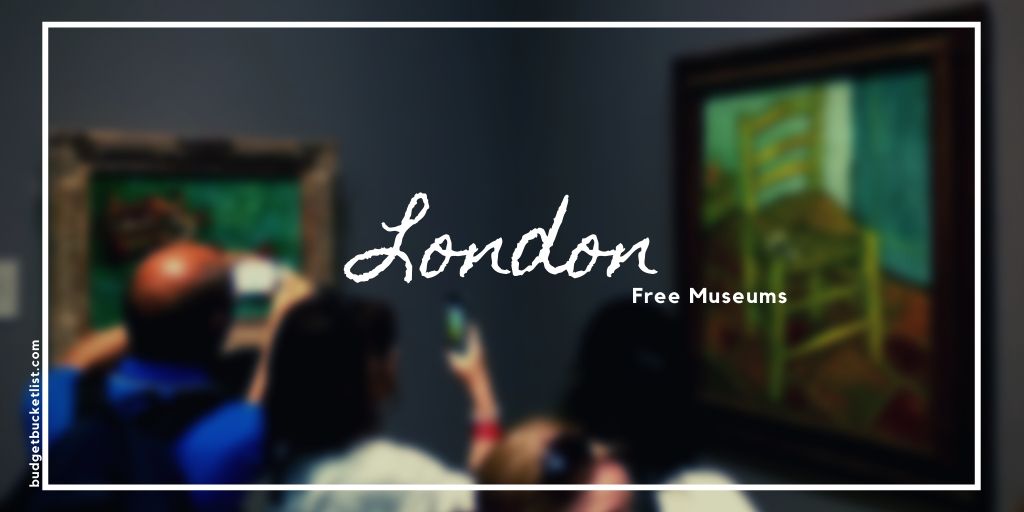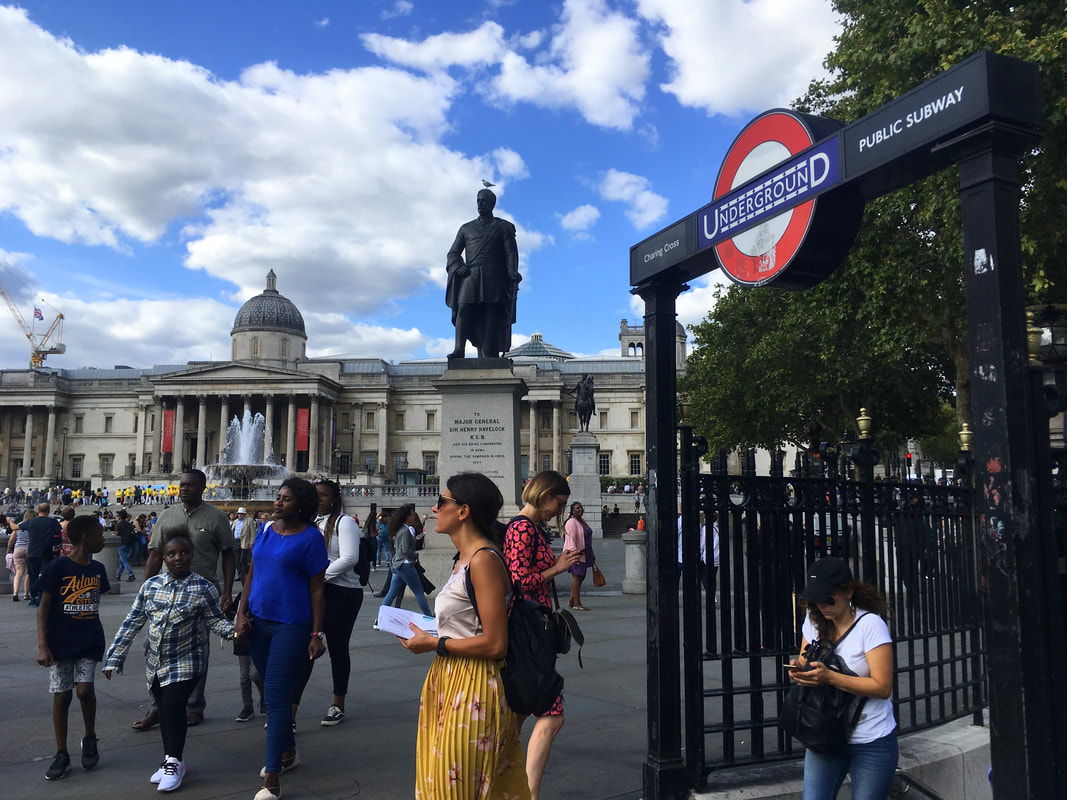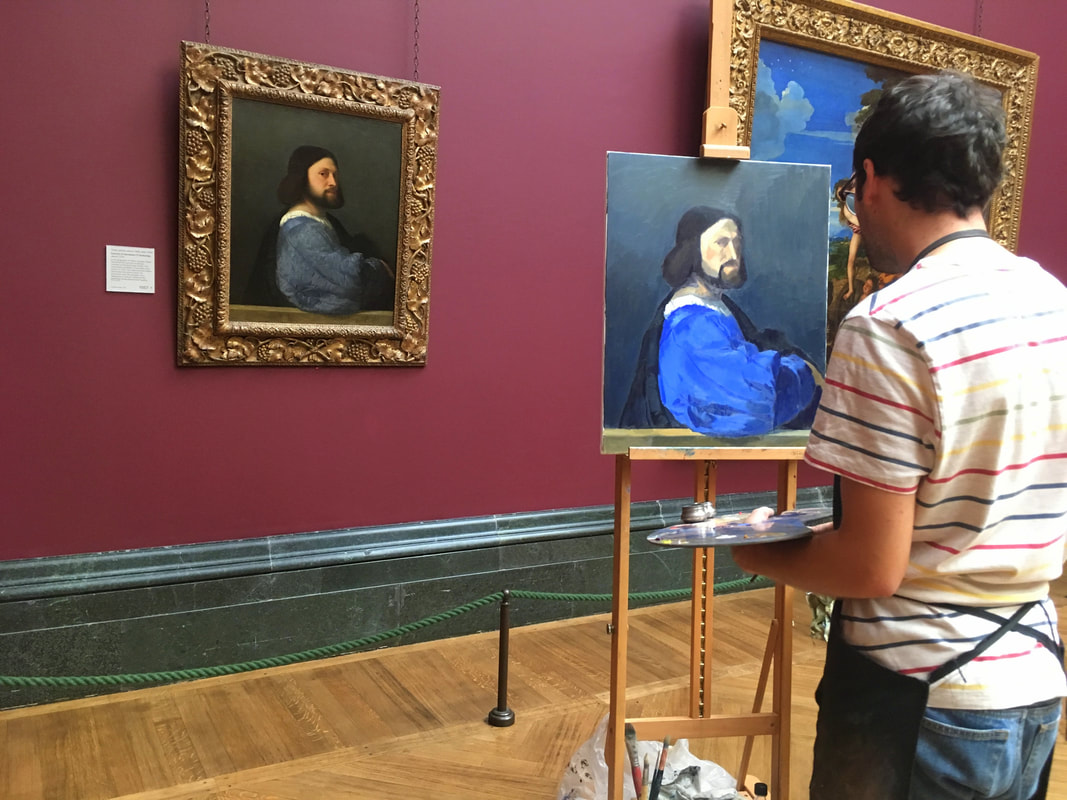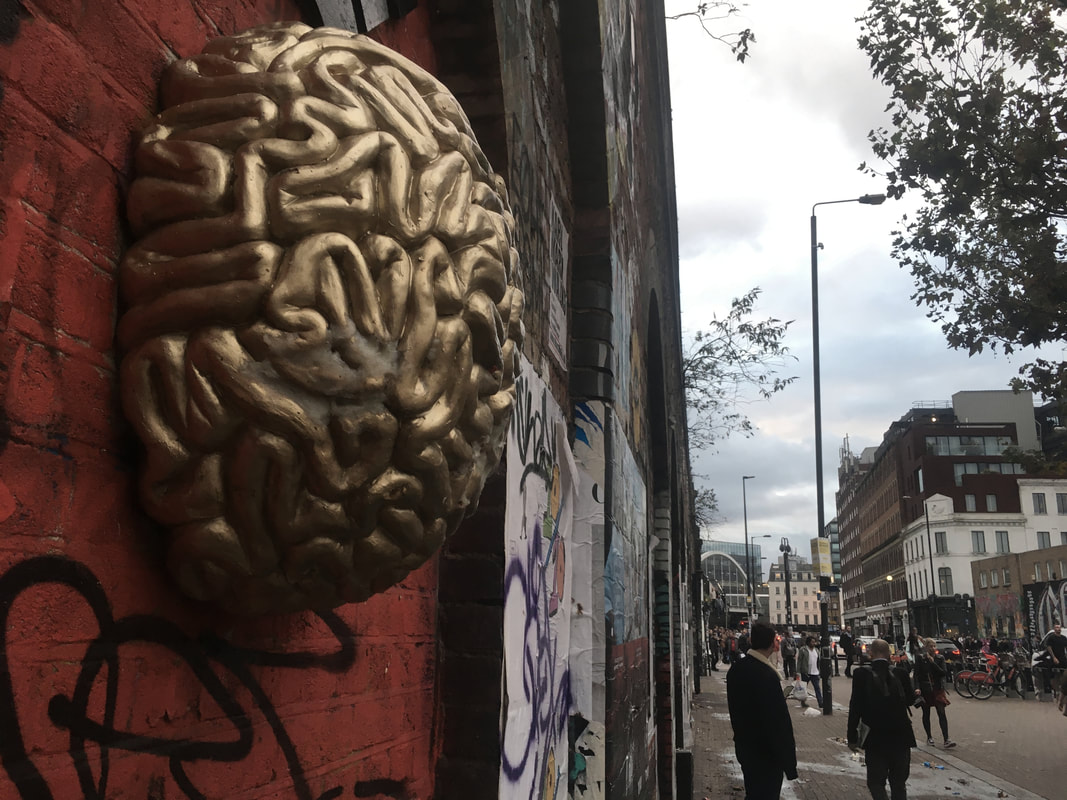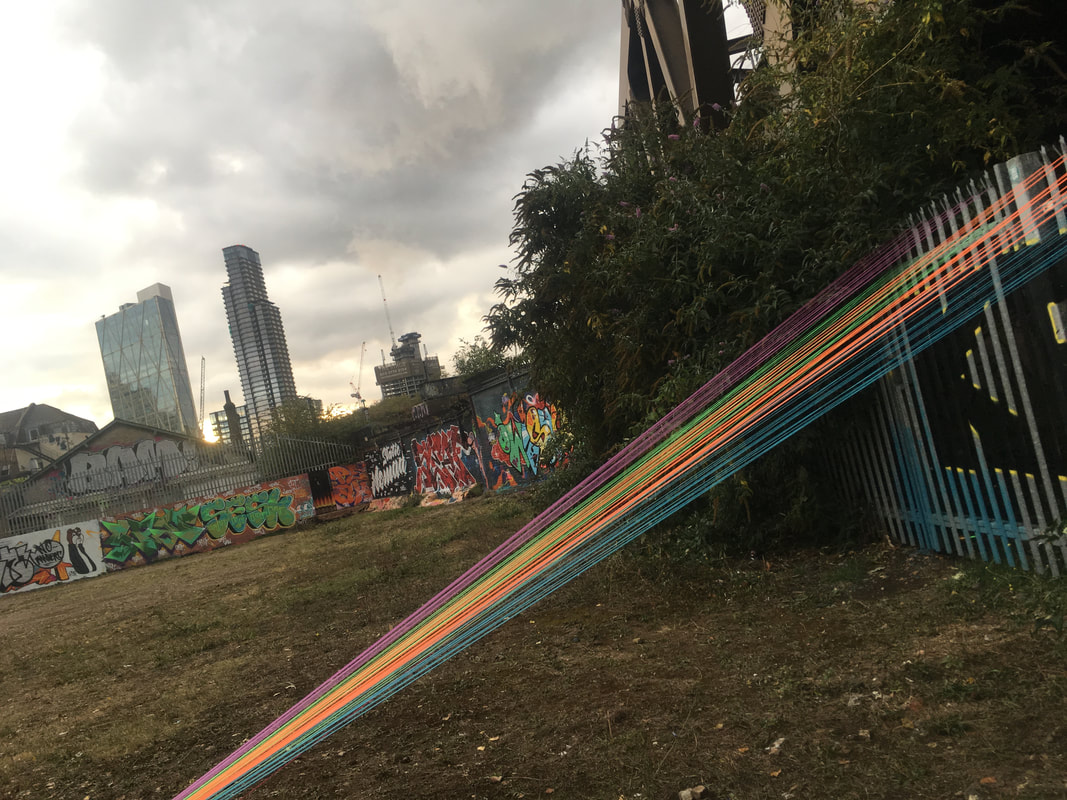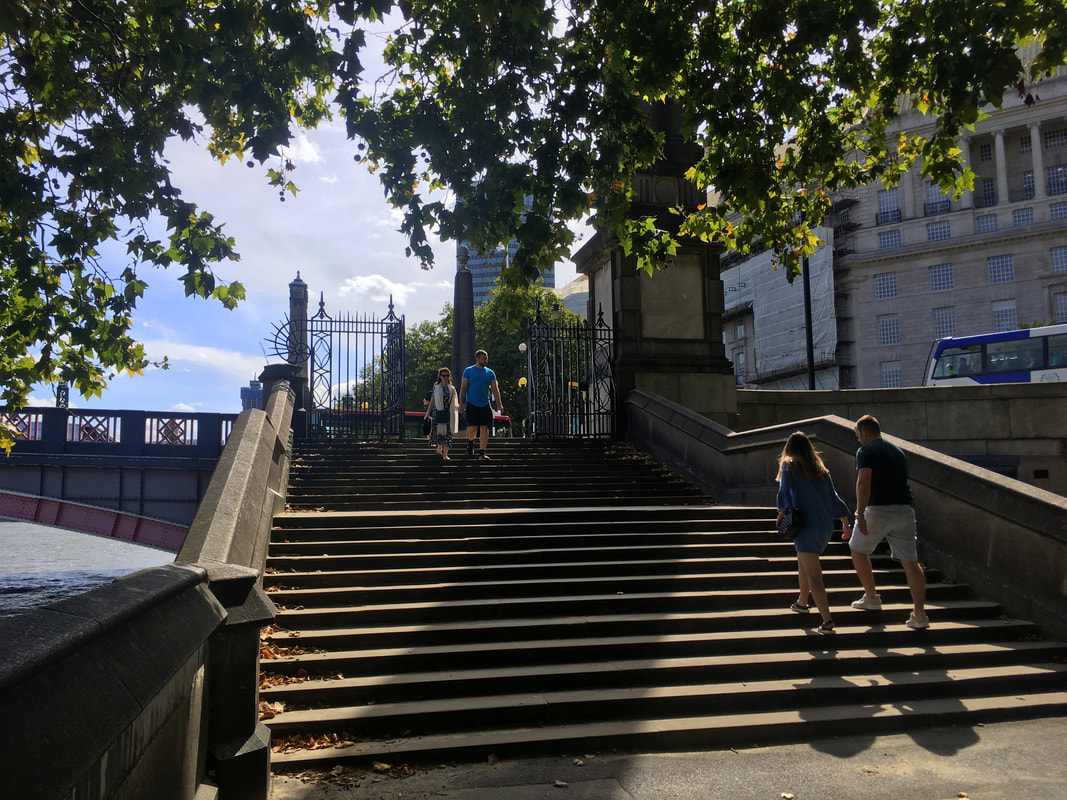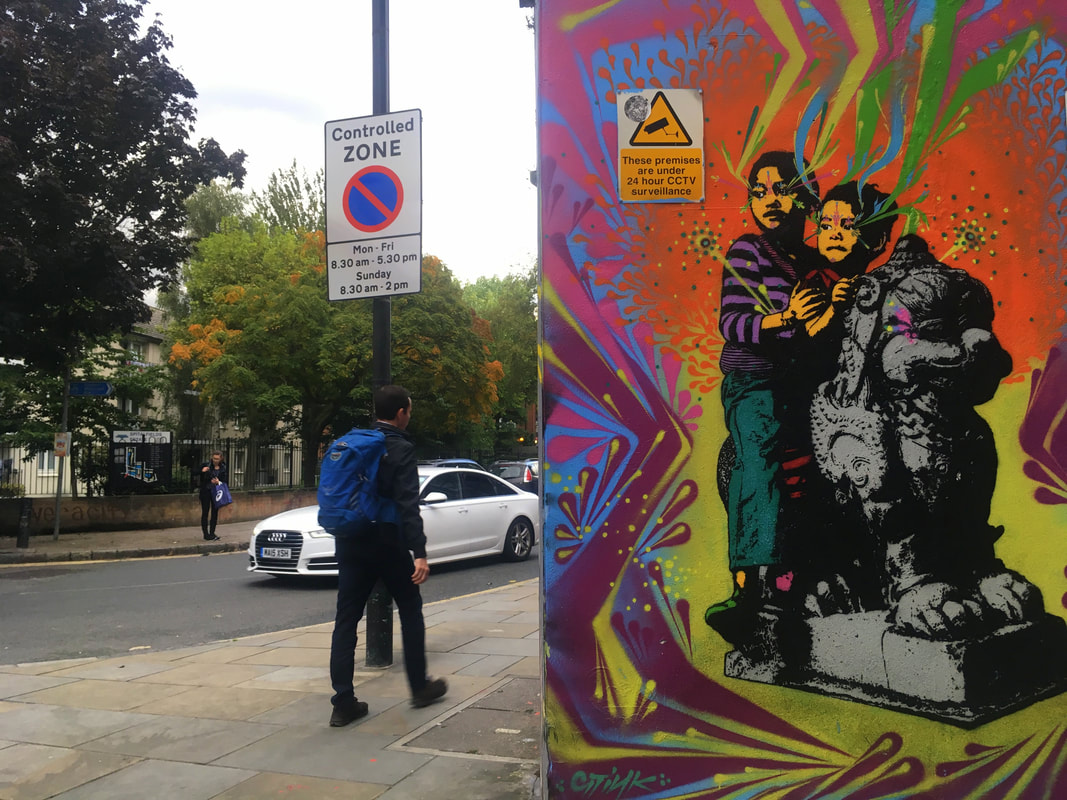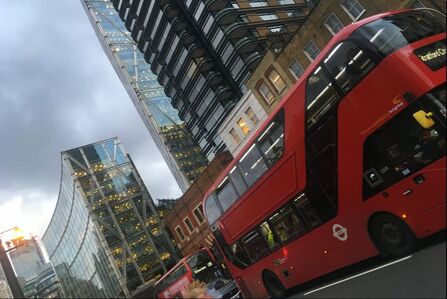London
For budget tips & compact place-specific travel info... Download my FREE Budget Fact Sheets. You're welcome.
| Download Steph's LONDON Quick Budget Fact Sheet | |
| File Size: | 298 kb |
| File Type: | |
Every time I visit London I throw a fearful glance into my wallet to verify if I’m financially prepared. To be entirely frank, I don’t know why my brain instantly connects Britain’s capital with extraordinary expenses, besides that its overall reputation precedes reality.
True, local prices are rather steep, perhaps more than in other western European countries, but I have to confess every one of my visits turned out to be a budget one. I paid about 50 bucks for a return flight from Amsterdam (EasyJet) or €15 for a 1-way ride with Flixbus (it’s shit, but hey); I didn’t pay for accommodation, be it because I was Couchsurfing or because my work connections in the hotel- and travel business fixed me a free room; and even food-wise I usually didn’t spend more than 5-6 pounds a day as I totally discovered the budget pleasures of apps like Too Good To Go (and if you’re still hungry: Aldi & Lidl are your friends). But isn’t traveling about sightseeing? Partially, yes, and even on that front I have fantastic news I’d like to focus on in this article:
What makes a city trip to London significantly less costly than visits to cities such as Paris, Amsterdam or Brussels, is that all of its most prominent museums are entirely free to enter.
True, local prices are rather steep, perhaps more than in other western European countries, but I have to confess every one of my visits turned out to be a budget one. I paid about 50 bucks for a return flight from Amsterdam (EasyJet) or €15 for a 1-way ride with Flixbus (it’s shit, but hey); I didn’t pay for accommodation, be it because I was Couchsurfing or because my work connections in the hotel- and travel business fixed me a free room; and even food-wise I usually didn’t spend more than 5-6 pounds a day as I totally discovered the budget pleasures of apps like Too Good To Go (and if you’re still hungry: Aldi & Lidl are your friends). But isn’t traveling about sightseeing? Partially, yes, and even on that front I have fantastic news I’d like to focus on in this article:
What makes a city trip to London significantly less costly than visits to cities such as Paris, Amsterdam or Brussels, is that all of its most prominent museums are entirely free to enter.
And I’m not just talking 1 or 2… I’m talking more than you could visit in an entire season:
[listed at a random order of preference – per category, check the links for the latest updates and opening times]
Art Museums
1. National Gallery
I must confess, I wasn’t instantly sold. Maybe because I had to row through the shiploads of jesus-propaganda before I finally hit the museum’s jackpot. Keep your spirits high though my little sailors, because once you fought your way through the rooms filled the brim with religious artefacts, thou shalt be rewarded: Da Vinci! Botticelli! Van Gogh! Toulouse-Lautrec! Monet! Vermeer! Klimt! Cezanne! Degas! Rubens! Rembrandt! Should I continue? Okay: Poussin! Bellini! Rousseau! Picasso! Renoir! Goya! Let’s just say that with over 2000 paintings pushed out of the brush anywhere in between the Middle Ages and the 20th Century, there must be something catering exactly to your artsy needs. Go.
[listed at a random order of preference – per category, check the links for the latest updates and opening times]
Art Museums
1. National Gallery
I must confess, I wasn’t instantly sold. Maybe because I had to row through the shiploads of jesus-propaganda before I finally hit the museum’s jackpot. Keep your spirits high though my little sailors, because once you fought your way through the rooms filled the brim with religious artefacts, thou shalt be rewarded: Da Vinci! Botticelli! Van Gogh! Toulouse-Lautrec! Monet! Vermeer! Klimt! Cezanne! Degas! Rubens! Rembrandt! Should I continue? Okay: Poussin! Bellini! Rousseau! Picasso! Renoir! Goya! Let’s just say that with over 2000 paintings pushed out of the brush anywhere in between the Middle Ages and the 20th Century, there must be something catering exactly to your artsy needs. Go.
2. British Museum
If you think 2000 paintings is a whole fucking lot, don’t even try to imagine the 8 million objects housed in the British Museum. More than just paintings, here you can find any sort of tangible artistic expression representing an essence of time or cultural value in the country of its origin, going way beyond the English borders. An (inter)national museum truly worth its status.
3. National Portrait Gallery
Yes, you have the National Gallery and the National Portrait Gallery. And you guessed it, this one’s main focus is – tadatadaaaaa – portraits! It’s not your general ordinary collection, I must add: it’s in fact the world’s largest. And besides just the artistic depiction of a person’s image, every artwork communicates a distinct insight about society, history, civilization and overall zeitgeist. Worth your citytrip-time!
4. Whitechapel Gallery
Admitted, I only visited because I had a Couchsurfing host living around the corner, but that said, I’d definitely not shuffle my half hour inside this place aside as time wasted. It’s a gallery focused on those ‘hard to understand’ pieces, so to say… You either love it or hate it. While here, have a stroll around this district, contradicting all stereotypes I ever had of (the touristic side of) London.
5. Serpentine Galleries
More of that cutting-edge stuff you can find right in the middle of Hyde Park, housed in two separate exhibition spaces devoted to all the confusing wonders of what we consider ‘contemporary art’. It’s definitely not for everyone, but if you self-classify as one of them enthusiasts: this is your spot. Besides hosting the works of a wide variety of local and international artists, this art hub offers ‘Saturday Talks’ and weirder-than-weird cinema.
If you think 2000 paintings is a whole fucking lot, don’t even try to imagine the 8 million objects housed in the British Museum. More than just paintings, here you can find any sort of tangible artistic expression representing an essence of time or cultural value in the country of its origin, going way beyond the English borders. An (inter)national museum truly worth its status.
3. National Portrait Gallery
Yes, you have the National Gallery and the National Portrait Gallery. And you guessed it, this one’s main focus is – tadatadaaaaa – portraits! It’s not your general ordinary collection, I must add: it’s in fact the world’s largest. And besides just the artistic depiction of a person’s image, every artwork communicates a distinct insight about society, history, civilization and overall zeitgeist. Worth your citytrip-time!
4. Whitechapel Gallery
Admitted, I only visited because I had a Couchsurfing host living around the corner, but that said, I’d definitely not shuffle my half hour inside this place aside as time wasted. It’s a gallery focused on those ‘hard to understand’ pieces, so to say… You either love it or hate it. While here, have a stroll around this district, contradicting all stereotypes I ever had of (the touristic side of) London.
5. Serpentine Galleries
More of that cutting-edge stuff you can find right in the middle of Hyde Park, housed in two separate exhibition spaces devoted to all the confusing wonders of what we consider ‘contemporary art’. It’s definitely not for everyone, but if you self-classify as one of them enthusiasts: this is your spot. Besides hosting the works of a wide variety of local and international artists, this art hub offers ‘Saturday Talks’ and weirder-than-weird cinema.
6. Royal Academy of Arts
More mainstream works can be found in one of London’s posterboys: The Royal Academy. Serving your daily dose of Michelangelo or Picasso, or a standard series of Greek and Roman statues to get your well-needed culture fix. Besides that, every Royal Academician has donated a work to the overall collection since 1768 (resulting in a total of 935 paintings, 25000 prints and drawings, 5000 photographs, 700 plaster casts and 350 sculptures). Already 250 years a leading name in England’s art scene, the Academy is, and I quote: “not just an art gallery, but a huge repository of free speech and free thinking.”
Comparable freebies: Royal Academy of Music Museum, The RCM Museum of Music, White Lodge Museum & Ballet Resource Centre
7. Victoria & Albert Museum
Another prominent one to cross off the list, this time with the accent on design objects in the categories such as furniture, fashion, jewelry and photography. Another facet, which is quite unique and particularly attracted my interest, is its documentation of the performing arts - including drama, dance and opera - by the means of memorabilia, manuscripts, audio-visual recordings and theatrical designs.
8. Tate Modern & Tate Britain
I might be confusing you when listing these under one heading, as unlike the Victoria & Albert, these are actually 2 entirely different museums. Well, not so different when it comes to its focus, which is obviously art (thick, fat, underlined and with exclamation marks), but housed in two different buildings and concentrated on two entirely different artistic streams. The Tate Britain focused on the highlights of British art from the 1500’s until now, featuring all the big names... The Tate Modern having developed itself into the focal point of the contemporary art scene. Both are a loud and clear YES.
Comparable freebies: UCL Art Museum
9. Hogarth’s House
William Hogarth was a celebrated painter and engraver at his time (18th century), mainly known for his work taking a piss on back-then modern society. In his artistic fight against injustice he drew attention to topics such as political corruption, poverty and (hurray) animal cruelty. This museum, situated in his former house, showcases the largest collection of his work.
More mainstream works can be found in one of London’s posterboys: The Royal Academy. Serving your daily dose of Michelangelo or Picasso, or a standard series of Greek and Roman statues to get your well-needed culture fix. Besides that, every Royal Academician has donated a work to the overall collection since 1768 (resulting in a total of 935 paintings, 25000 prints and drawings, 5000 photographs, 700 plaster casts and 350 sculptures). Already 250 years a leading name in England’s art scene, the Academy is, and I quote: “not just an art gallery, but a huge repository of free speech and free thinking.”
Comparable freebies: Royal Academy of Music Museum, The RCM Museum of Music, White Lodge Museum & Ballet Resource Centre
7. Victoria & Albert Museum
Another prominent one to cross off the list, this time with the accent on design objects in the categories such as furniture, fashion, jewelry and photography. Another facet, which is quite unique and particularly attracted my interest, is its documentation of the performing arts - including drama, dance and opera - by the means of memorabilia, manuscripts, audio-visual recordings and theatrical designs.
8. Tate Modern & Tate Britain
I might be confusing you when listing these under one heading, as unlike the Victoria & Albert, these are actually 2 entirely different museums. Well, not so different when it comes to its focus, which is obviously art (thick, fat, underlined and with exclamation marks), but housed in two different buildings and concentrated on two entirely different artistic streams. The Tate Britain focused on the highlights of British art from the 1500’s until now, featuring all the big names... The Tate Modern having developed itself into the focal point of the contemporary art scene. Both are a loud and clear YES.
Comparable freebies: UCL Art Museum
9. Hogarth’s House
William Hogarth was a celebrated painter and engraver at his time (18th century), mainly known for his work taking a piss on back-then modern society. In his artistic fight against injustice he drew attention to topics such as political corruption, poverty and (hurray) animal cruelty. This museum, situated in his former house, showcases the largest collection of his work.
10. Guildhall Art Gallery & Roman Amphitheatre
Did you know that London has an actual Roman amphitheatre? Well, now you do. You don’t have to go all the way to Rome the relive gladiator times. Like this is not a reason on its own to check out this free highlight, you can combine it with a visit to the Guildhall Art Gallery at the exact same location (in fact, the gallery was there first and served as the spot were archaeologists stumbled upon the theatre in 1988).
11. The Wallace Collection
The building alone is a reason to travel down to Oxford Street. But while you’re there, you might as well pop in, as it’s definitely worth your while and it won’t cost you a dime. What can you expect? 18th century French works, a tad of Rembrandt, some Renaissance curiosities and some displays of British arms and armour. Interesting. Thanks Richard Wallace!
12. Sir John Soane’s Museum
Another privileged rich guy who liked to collect art. Well, good for us, as now we can go check out their impressive collections… for free! Mister Soane was an architect for profession, which kind of gives away the overall focus of his assemblage of artworks: Architectural drawings, but also paintings and antiques is what lures in the crowds. Into Egyptian history? You came to the right place, as there’s even a sarcophagus to brighten up the day.
12. Queen’s House
Housed in the former royal residence in Greenwich, a collection of marine-themed paintings and 17th-20th century portraits (of which the most famous Elizabeth I portrait) can now be admired. More than that collection on its own, it’s the house and its historical value that pays off your visit.
13. Kenwood House
Hampstead Heath is worth a visit, if only for the free-to-enter Kenwood House providing a sneak-peek into the London that once was. Stroll around the landscaped gardens, hunt hidden treasures in the second-hand book shop (I loooooove second-hand book shops) or spot an actual Rembrandt within the extensive art collection.
Comparable freebies: Geffrye Museum, Burg House & Hampstead Museum, Fulham Palace House & Garden, Boston Manor House, Bruce Castle Museum, Charlton House, Forty Hall Museum, William Morris Gallery
Did you know that London has an actual Roman amphitheatre? Well, now you do. You don’t have to go all the way to Rome the relive gladiator times. Like this is not a reason on its own to check out this free highlight, you can combine it with a visit to the Guildhall Art Gallery at the exact same location (in fact, the gallery was there first and served as the spot were archaeologists stumbled upon the theatre in 1988).
11. The Wallace Collection
The building alone is a reason to travel down to Oxford Street. But while you’re there, you might as well pop in, as it’s definitely worth your while and it won’t cost you a dime. What can you expect? 18th century French works, a tad of Rembrandt, some Renaissance curiosities and some displays of British arms and armour. Interesting. Thanks Richard Wallace!
12. Sir John Soane’s Museum
Another privileged rich guy who liked to collect art. Well, good for us, as now we can go check out their impressive collections… for free! Mister Soane was an architect for profession, which kind of gives away the overall focus of his assemblage of artworks: Architectural drawings, but also paintings and antiques is what lures in the crowds. Into Egyptian history? You came to the right place, as there’s even a sarcophagus to brighten up the day.
12. Queen’s House
Housed in the former royal residence in Greenwich, a collection of marine-themed paintings and 17th-20th century portraits (of which the most famous Elizabeth I portrait) can now be admired. More than that collection on its own, it’s the house and its historical value that pays off your visit.
13. Kenwood House
Hampstead Heath is worth a visit, if only for the free-to-enter Kenwood House providing a sneak-peek into the London that once was. Stroll around the landscaped gardens, hunt hidden treasures in the second-hand book shop (I loooooove second-hand book shops) or spot an actual Rembrandt within the extensive art collection.
Comparable freebies: Geffrye Museum, Burg House & Hampstead Museum, Fulham Palace House & Garden, Boston Manor House, Bruce Castle Museum, Charlton House, Forty Hall Museum, William Morris Gallery
14. Royal Institute of British Architects (RIBA)
Enthusiasts of another line in art, architecture this time, can pick their hearts in the RIBA. Probably London’s most extensive collection of drawings, photographs, objects, artefacts, archives, manuscripts and models of architectural nature can be traced down as this very spot.
Comparable freebies: Bourne Hall Museum
15. Design Museum
Once you broadened your architectural knowledge in the RIBA, it’s now time to dive head-first into the interior design of all the fantastically crafted buildings. There’s no better place to do so in London than in the Design Museum, mixing and matching it up with continuously changing exhibitions about anything from furniture to fashion to crafts.
Science Museums
16. Science Museum
Science shapes our world. Not only our understanding of everything around us, but also the concrete environment we created. The device you’re reading this on? Science. The chair (or toilet) you’re sitting on? Science. How you just warmed up your snack, the mode of transport you took today, the glasses you have on your nose? Science, science, science. From spacecrafts to medicine, and from robots to communication technologies: London’s Science Museum covers it all with interactive displays that allow you to learn, discover and wonder.
Comparable freebies: The Faraday Museum at the Royal Institution
17. Wellcome Collection
No typo. Sir Henry Wellcome was a pharmacist, entrepreneur, philanthropist and, what left him with fame until today: a collector. In between 1890 and 1936 he collected a wide arrange of objects and curiosities around the topics of quackery, art and (18th century) cartoons, botany, optics, health and neural stem cell study, and more interesting excrescences of scientific research of all kinds. Or, how the museum direction likes to put it, “a free museum and library exploring health, life and our place in the world.”
Comparable freebies: British Dental Association Museum, Royal London Hospital Museum, Anaesthesia Heritage Collection, Bethlem Museum of the Mind, British Optical Association Museum, John Wesley’s House, Royal College of Physicians, Royal Pharmaceutical Society Museum, Royal Hospital Chelsea Museum, The Stephens Collection, Museum of Garden History
Enthusiasts of another line in art, architecture this time, can pick their hearts in the RIBA. Probably London’s most extensive collection of drawings, photographs, objects, artefacts, archives, manuscripts and models of architectural nature can be traced down as this very spot.
Comparable freebies: Bourne Hall Museum
15. Design Museum
Once you broadened your architectural knowledge in the RIBA, it’s now time to dive head-first into the interior design of all the fantastically crafted buildings. There’s no better place to do so in London than in the Design Museum, mixing and matching it up with continuously changing exhibitions about anything from furniture to fashion to crafts.
Science Museums
16. Science Museum
Science shapes our world. Not only our understanding of everything around us, but also the concrete environment we created. The device you’re reading this on? Science. The chair (or toilet) you’re sitting on? Science. How you just warmed up your snack, the mode of transport you took today, the glasses you have on your nose? Science, science, science. From spacecrafts to medicine, and from robots to communication technologies: London’s Science Museum covers it all with interactive displays that allow you to learn, discover and wonder.
Comparable freebies: The Faraday Museum at the Royal Institution
17. Wellcome Collection
No typo. Sir Henry Wellcome was a pharmacist, entrepreneur, philanthropist and, what left him with fame until today: a collector. In between 1890 and 1936 he collected a wide arrange of objects and curiosities around the topics of quackery, art and (18th century) cartoons, botany, optics, health and neural stem cell study, and more interesting excrescences of scientific research of all kinds. Or, how the museum direction likes to put it, “a free museum and library exploring health, life and our place in the world.”
Comparable freebies: British Dental Association Museum, Royal London Hospital Museum, Anaesthesia Heritage Collection, Bethlem Museum of the Mind, British Optical Association Museum, John Wesley’s House, Royal College of Physicians, Royal Pharmaceutical Society Museum, Royal Hospital Chelsea Museum, The Stephens Collection, Museum of Garden History
Nature & Maritime Museums
18. Natural History Museum
Why go to a museum about nature when England is actually filled to the brim with wonderful greenery to indulge in? Isn’t it quite contradictory to chuck the concept of the outdoors inside of an indoors display? Good question, but one possible answer is that some wonderful marvels of the natural world are no longer among us, or incredibly hard to spot for an urban citizen. Hence, the Natural History Museum: Your go-to for dinosaur skeletons and dodo’s.
Comparable freebies: Grant Museum of Zoology, Cuming Museum, UCL Geology Collections
19. Horniman Museum & Gardens
The kind of odd cousin from the Natural History Museum comes in the form of the Horniman. Digital coral reef, dragonfly-view-of-the-world-boxes, Indian sursrngar lutes and a stuffed merman (the horny man?) are only a few of the many intriguing exhibits of this museum I really pity I didn’t visit yet (a reason to return to London once again!).
20. Hunterian Museum
In the same line as the Horniman (it just feels nice to say it like that), the Hunterian Museum attracts the weirdest around the globe. Be ready to witness a freakshow-exhibition of organs in jars and mummified heads. Post-lunch visits only!
21. National Maritime Museum
There’s a reason such a significant chunk of the world speaks English. However much Brexit pushes them back into their own shell nowadays, the British used to spread out all over the globe (for doubtful reasons I leave in the middle here) using ships as their go-to mode of transport. That’s what this museum is about: from sea battles to ‘exploratory’ expeditions underlined with objects such as bottled ships, ancient maps and stuffed polar bears.
22. Museum of London Docklands
The London Docklands riverfront was once the world’s largest port and the focal punt of the city’s 19th century supremacy on the naval scene. Forlorn times, as in the ’60s and ‘70s the upcoming container cargo system pushed its importance to the background. For those longing to relive the Docklands’ glory days this museum is in place, bringing back a part of history forming an essential factor in London’s upcoming prosperity.
Comparable freebies: The Brunel Museum
18. Natural History Museum
Why go to a museum about nature when England is actually filled to the brim with wonderful greenery to indulge in? Isn’t it quite contradictory to chuck the concept of the outdoors inside of an indoors display? Good question, but one possible answer is that some wonderful marvels of the natural world are no longer among us, or incredibly hard to spot for an urban citizen. Hence, the Natural History Museum: Your go-to for dinosaur skeletons and dodo’s.
Comparable freebies: Grant Museum of Zoology, Cuming Museum, UCL Geology Collections
19. Horniman Museum & Gardens
The kind of odd cousin from the Natural History Museum comes in the form of the Horniman. Digital coral reef, dragonfly-view-of-the-world-boxes, Indian sursrngar lutes and a stuffed merman (the horny man?) are only a few of the many intriguing exhibits of this museum I really pity I didn’t visit yet (a reason to return to London once again!).
20. Hunterian Museum
In the same line as the Horniman (it just feels nice to say it like that), the Hunterian Museum attracts the weirdest around the globe. Be ready to witness a freakshow-exhibition of organs in jars and mummified heads. Post-lunch visits only!
21. National Maritime Museum
There’s a reason such a significant chunk of the world speaks English. However much Brexit pushes them back into their own shell nowadays, the British used to spread out all over the globe (for doubtful reasons I leave in the middle here) using ships as their go-to mode of transport. That’s what this museum is about: from sea battles to ‘exploratory’ expeditions underlined with objects such as bottled ships, ancient maps and stuffed polar bears.
22. Museum of London Docklands
The London Docklands riverfront was once the world’s largest port and the focal punt of the city’s 19th century supremacy on the naval scene. Forlorn times, as in the ’60s and ‘70s the upcoming container cargo system pushed its importance to the background. For those longing to relive the Docklands’ glory days this museum is in place, bringing back a part of history forming an essential factor in London’s upcoming prosperity.
Comparable freebies: The Brunel Museum
History Museums
23. Museum of London
History is never just a closed chapter in the past. It in fact explains and influences everything you see around you, all that you experience in culture and mindsets, and it determines why one place looks and feels so different than the other, aside from climate and natural variety. Why is London as it is right now? Why does it have the current architecture, the industries and crafts, and why do people think, act and speak a certain way? What processes lie underneath and what phases did it pass through to make this capital city what it is today? You find the answers in the Museum of London.
Comparable freebies: Greenwich Heritage Centre, Gunnersbury Park Museum, Hackney Museum, Harrow Museum, Islington Museum, Merton Heritage Centre, Museum of Croydon, Museum of Immigration and Diversity, Museum of Richmond, Twickenham Museum, Barn Museum of Nostalgia
24. London Mithraeum
And what before London was London? A visit to the underground Temple of Mithras, a Roman deity who was born from a rock and ‘famous’ for killing a bull and subsequently feasting on it with the sun, will bring you back to 240 A.D. When London was built no one had the slightest idea it was laying part of its foundations on this sanctum, only to be rediscovered in 1954. Worth a look!
Comparable freebies: Petrie Museum of Egyptian Archaeology, St. Bride’s Crypt, Museum of Fulham Palace, Valence House Museum, Guildhall Art Gallery & Roman Amphitheatre (scroll back)
25. British Library
I say England, and you - an intellectual - say...? Shakespeare, that’s right! His work, and that of many many many others can be found in the Walhalla of literary treasures called the British Library. More than just a place for reading, study and reflection, it hosts many interesting exhibitions you can visit for free.
Comparable freebies: Museum of Freemasonry, The Rose Theatre Exhibition
26. V&A Museum of Childhood
Go back into your own personal history, and that of entire generations, in this museum focused on childhood objects from the 1600s until now. “Objects in the collection speak to both the lived experience of children and how the world has been designed with children in mind.” Expect to find a colourful collection of doll houses, board games, costume collections, nursery equipment and paintings, photographs and drawings depicting young ones playing or expressing their playful minds.
Comparable freebies: Livesey Museum for Children, The Ragged School Museum
23. Museum of London
History is never just a closed chapter in the past. It in fact explains and influences everything you see around you, all that you experience in culture and mindsets, and it determines why one place looks and feels so different than the other, aside from climate and natural variety. Why is London as it is right now? Why does it have the current architecture, the industries and crafts, and why do people think, act and speak a certain way? What processes lie underneath and what phases did it pass through to make this capital city what it is today? You find the answers in the Museum of London.
Comparable freebies: Greenwich Heritage Centre, Gunnersbury Park Museum, Hackney Museum, Harrow Museum, Islington Museum, Merton Heritage Centre, Museum of Croydon, Museum of Immigration and Diversity, Museum of Richmond, Twickenham Museum, Barn Museum of Nostalgia
24. London Mithraeum
And what before London was London? A visit to the underground Temple of Mithras, a Roman deity who was born from a rock and ‘famous’ for killing a bull and subsequently feasting on it with the sun, will bring you back to 240 A.D. When London was built no one had the slightest idea it was laying part of its foundations on this sanctum, only to be rediscovered in 1954. Worth a look!
Comparable freebies: Petrie Museum of Egyptian Archaeology, St. Bride’s Crypt, Museum of Fulham Palace, Valence House Museum, Guildhall Art Gallery & Roman Amphitheatre (scroll back)
25. British Library
I say England, and you - an intellectual - say...? Shakespeare, that’s right! His work, and that of many many many others can be found in the Walhalla of literary treasures called the British Library. More than just a place for reading, study and reflection, it hosts many interesting exhibitions you can visit for free.
Comparable freebies: Museum of Freemasonry, The Rose Theatre Exhibition
26. V&A Museum of Childhood
Go back into your own personal history, and that of entire generations, in this museum focused on childhood objects from the 1600s until now. “Objects in the collection speak to both the lived experience of children and how the world has been designed with children in mind.” Expect to find a colourful collection of doll houses, board games, costume collections, nursery equipment and paintings, photographs and drawings depicting young ones playing or expressing their playful minds.
Comparable freebies: Livesey Museum for Children, The Ragged School Museum
War Museums & Other Terrible Things
27. Imperial War Museum
While many Englishmen (but luckily definitely not all) currently express xenophobe sentiments relating to ideas of foreigners taking advantage of their resources, they seem to conveniently forget that that was what England (and Spain – and Holland – and Portugal – and France – and many more, but definitely predominantly England and Spain) was all about over a significantly long stretch of history. In fact, England managed to invade no less than 178 nations (leaving only 22 untouched worldwide) to subsequently exploit local resources, suppress and enslave populations and literally spread diseases all over the globe. Instead of dying from shame and embarrassment for that less-than-honourable part of history, apparently some people take pride in this prior enforced dominance. Enough to build a museum around the subject.
27. Imperial War Museum
While many Englishmen (but luckily definitely not all) currently express xenophobe sentiments relating to ideas of foreigners taking advantage of their resources, they seem to conveniently forget that that was what England (and Spain – and Holland – and Portugal – and France – and many more, but definitely predominantly England and Spain) was all about over a significantly long stretch of history. In fact, England managed to invade no less than 178 nations (leaving only 22 untouched worldwide) to subsequently exploit local resources, suppress and enslave populations and literally spread diseases all over the globe. Instead of dying from shame and embarrassment for that less-than-honourable part of history, apparently some people take pride in this prior enforced dominance. Enough to build a museum around the subject.
28. National Army Museum
More things people easily confuse with something honourable: the army. The glorification of violence, commanded by many layers and ranks in order to toss around responsibility until it vanishes, trickling all the way down to the lowest executing parties who have very little to do with (and often no personal ties with or even knowledge of) the original goals and ideas they’re dying for on the front line. Poverty turning good men into assassins, society at its turn converting it into heroism to motivate future generations to die for the goals they’d never die for themselves. Did I sell this museum to you? I hope not.
Comparable freebies: Battle of Britain Bunker, Jewish Military Museum
29. Royal Air Force Museums
More assassins, but killing from the air this time. BUT, if you’re capable to look passed that, this is actually quite captivating for those wanting to learn about the history of aircrafts and the scientific background of aircraft technique.
30. Bank of England Museum
Another weapon of mass destruction… dividing humans, determining who holds the power, who has their children dying from hunger and who has to pay for their crimes and who doesn’t: Money, glorious money! The banks being the true assholes of the story of course, creating money while simultaneously creating an equal amount of debt enslaving the nation. A museum of the bank, creating the illusion it’s something of the past we can now smirkingly look back on in our new Fresconian, Venus Society… but sadly it isn’t.
More things people easily confuse with something honourable: the army. The glorification of violence, commanded by many layers and ranks in order to toss around responsibility until it vanishes, trickling all the way down to the lowest executing parties who have very little to do with (and often no personal ties with or even knowledge of) the original goals and ideas they’re dying for on the front line. Poverty turning good men into assassins, society at its turn converting it into heroism to motivate future generations to die for the goals they’d never die for themselves. Did I sell this museum to you? I hope not.
Comparable freebies: Battle of Britain Bunker, Jewish Military Museum
29. Royal Air Force Museums
More assassins, but killing from the air this time. BUT, if you’re capable to look passed that, this is actually quite captivating for those wanting to learn about the history of aircrafts and the scientific background of aircraft technique.
30. Bank of England Museum
Another weapon of mass destruction… dividing humans, determining who holds the power, who has their children dying from hunger and who has to pay for their crimes and who doesn’t: Money, glorious money! The banks being the true assholes of the story of course, creating money while simultaneously creating an equal amount of debt enslaving the nation. A museum of the bank, creating the illusion it’s something of the past we can now smirkingly look back on in our new Fresconian, Venus Society… but sadly it isn’t.
More London Budget Tips
- Free Street Art: Brick Lane, Sclater Street, Shoreditch High Street, Leake Street Tunnel, Camden , Surrey Street Market, Hackney Wick, Walthamstow (Wood Street / Hoe Street), Dulwich, Penge, Brixton & more
- Free Sights & Activities: Changing of the Guard, Parliament Square, Millennium Bridge, Tower Bridge, River Thames, St. Katharine Docks, King Cross Station (Harry Potter photo opportunities), Piccadilly Circus, Canary Wharf. Check the Free Budget Fact Sheet for more.
- The Opera House offers free recitals at Monday lunchtime. Book ahead.
- Queue at Cromwell Green to attend parliamentary debates for free.
- Angel Comedy in Camden hosts free stand-up comedy.
- Prebook paid sights and activities on websites and apps like 365, Groupon, Living Social and Voucher Cloud. Cheap theatre tickets can be bought on the TKTS Booth in Leicester Square.
- Save up to 50% on train and bus tickets by prebooking them in advance online (the earlier, the cheaper). In London itself a charged Oyster Card is necessary for public transport use: it costs £5, which will be refunded upon return. Santander bicycles require (short-term) subscription, but will allow you to use the bike for free in episodes of max. 30 minutes.
- Toilets are generally paid in London… except in museums. Use the above suggestions for free toilet visits and water bottle refills.
- Go into famous churches (like Westminster Abbey) during mass or organ recitals (usually on Sunday) to avoid entrance prices.
In order to support the travelers’ community, I spend many hours per week to adequately document all information and advices for prospective visitors, accompanied by a (hopefully) entertaining insight into my personal observations and experiences. This service is and will remain free. However, if you voluntarily want to make a contribution and support my travels and thus the creation of new stories and information supply, here is the button you’re looking for:
Related:
- Discover England: Bath, Brighton, Isle of Wight, Portsmouth and London!
- Go Green, Go Scotland: Easdale, Edinburgh, Glasgow, Glencoe / The Highlands and Isle of Skye
- Geocaching Wales: Cardiff & Region
- In search of Harry Potter: Rowling's hometown, Hogwarts, Hagrid's Hut and a ride in the Hogwarts Express
- Unravel the mysteries of Serbia
- Europe's best skiing & hiking: Get your ass over to jaw-dropping Switzerland!
- Visit Europe's mini-countries: Gibraltar, Liechtenstein, Luxemburg, Kosovo & Wales!
- Guest Blog 'Kosovo Girl Travels': Travel tips and stories from Kosovo's first and only travelblogger!
- The 3 golden rules to travel Sofia on a budget! & Why you shouldn’t miss out on Plovdiv! [Bulgaria]
- The film locations of Game of Thrones: King's Landing in Sevilla [Spain]
- A visit to Lord of the Ring's Hobbiton [Matamata, New Zealand]
- A housesit next to a Lord of the Rings film location: Port Waikato, New Zealand
- Citytripping in Denmark's capital: Copenhagen
- Where modern meets classic: Vilnius, Lithuania
- Discover more Belgium: Antwerp & the most kick-ass Flanders itinerary!
- 8 ways to save money in Vienna, Austria
- Medieval Holland kept alive: Den Bosch & Haarlem
- 3 reasons why you need to visit Nijmegen [The Netherlands]
- A capital surrounded by scenic little villages: Lisbon, Portugal
- Spanish citytrips: Barcelona, Malaga & Sevilla
- German gems: Aachen & Frankfurt am Main
- Abseiling in Banos, Ecuador
- Graffiti hotspots in South America: Bogota [Colombia], Sao Paulo & Porto Alegre [Brazil], Valparaiso [Chile], Asunción [Paraguay]
- Malaysia's street art hotspots: Penang & Ipoh!
- Check out Budget Bucket List's FAVORITE HIKING DESTINATIONS worldwide!
- Discover England: Bath, Brighton, Isle of Wight, Portsmouth and London!
- Go Green, Go Scotland: Easdale, Edinburgh, Glasgow, Glencoe / The Highlands and Isle of Skye
- Geocaching Wales: Cardiff & Region
- In search of Harry Potter: Rowling's hometown, Hogwarts, Hagrid's Hut and a ride in the Hogwarts Express
- Unravel the mysteries of Serbia
- Europe's best skiing & hiking: Get your ass over to jaw-dropping Switzerland!
- Visit Europe's mini-countries: Gibraltar, Liechtenstein, Luxemburg, Kosovo & Wales!
- Guest Blog 'Kosovo Girl Travels': Travel tips and stories from Kosovo's first and only travelblogger!
- The 3 golden rules to travel Sofia on a budget! & Why you shouldn’t miss out on Plovdiv! [Bulgaria]
- The film locations of Game of Thrones: King's Landing in Sevilla [Spain]
- A visit to Lord of the Ring's Hobbiton [Matamata, New Zealand]
- A housesit next to a Lord of the Rings film location: Port Waikato, New Zealand
- Citytripping in Denmark's capital: Copenhagen
- Where modern meets classic: Vilnius, Lithuania
- Discover more Belgium: Antwerp & the most kick-ass Flanders itinerary!
- 8 ways to save money in Vienna, Austria
- Medieval Holland kept alive: Den Bosch & Haarlem
- 3 reasons why you need to visit Nijmegen [The Netherlands]
- A capital surrounded by scenic little villages: Lisbon, Portugal
- Spanish citytrips: Barcelona, Malaga & Sevilla
- German gems: Aachen & Frankfurt am Main
- Abseiling in Banos, Ecuador
- Graffiti hotspots in South America: Bogota [Colombia], Sao Paulo & Porto Alegre [Brazil], Valparaiso [Chile], Asunción [Paraguay]
- Malaysia's street art hotspots: Penang & Ipoh!
- Check out Budget Bucket List's FAVORITE HIKING DESTINATIONS worldwide!
